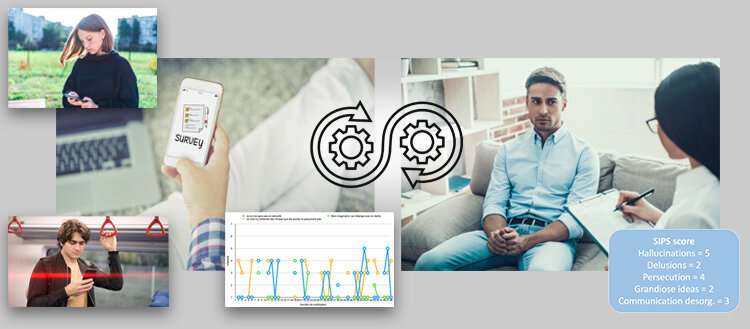
Three percent of the population suffers from psychotic disorders, which are an important cause of disability in adolescents and young adults. In order to adapt the medical follow-up and to avoid a worsening of the disorder, it is essential to closely monitor the evolution of psychotic symptoms, both in terms of frequency and intensity. Today, this is done through follow-up interviews every three months. However, these interviews must be carried out by trained professionals, last two hours and are not necessarily accessible to everyone. This is why a team from the University of Geneva (UNIGE) has developed an application that makes it possible to monitor the evolution of the symptoms of a person at risk for psychosis on a daily basis. This “remote” monitoring would make it possible to space out face-to-face sessions and make them necessary only when the person is going through a crisis phase or an exacerbation of symptoms. In addition, it will be possible for psychologists to determine what causes the appearance of symptoms in the person’s daily life. These results can be read in the journal Schizophrenia Research.
Adolescence is a pivotal period for the development of psychotic disorders. One of the main challenges is to detect individuals as early as possible during a so-called “high-risk” phase of psychosis in order to avoid the worsening of symptoms and ensure appropriate care and follow-up. To study the development of psychosis, scientists are following patients suffering from a microdeletion of chromosome 22q11.2, a genetic condition associated with an increased risk of psychosis such as schizophrenia.
People at risk for psychosis are traditionally assessed using a semi-standardized interview called SIPS (Structured Interview for Psychosis-Risk Syndromes). “These questionnaires are very reliable, but they need to be carried out for two hours by trained professionals every three months approximatively, in order to be able to monitor the evolution of symptoms,” explains Maude Schneider, professor at the Faculty of Psychology and Educational Sciences (FPSE) in UNIGE and the last author of the study. “We asked ourselves if we could develop an application that would allow us to monitor the person on a more regular basis and in their daily environment,” she continues.
An application that determines the frequency and intensity of symptoms
The aim of the study is to understand the functioning of a person at risk for psychosis in his or her naturalistic context through a daily assessment of symptoms. “We have developed an application that asks the person ten questions over six days in a row about their positive affects (Are you happy? relaxed?), their negative affects (Are you sad? Anxious? Angry?) and the presence of psychotic symptoms (Does your imagination mix with reality? Do you hear things that others do not perceive? Do you have to be on your guards?”, explains Clémence Feller, researcher at Faculty of Psychology and Educational Sciences in UNIGE and first author of the study. Eight times a day, the participants were asked to answer these questions and rate their state on a scale ranging from 1 (not at all) to 7 (extremely).
In order to determine whether the application provided information that was consistent with “classical” assessment methods, the participants were also assessed using the SIPS interview. “We assessed 86 people between the age of 11 and 27 with the application, 37 of whom were diagnosed with a microdeletion of chromosome 22q11.2,” Clémence Feller says.
Adapting a patient’s monitoring through the application
“Our first observation is that people with psychotic symptoms are perfectly capable of answering the questions in the application on a daily basis, which allows a complete assessment of their symptoms over the course of the day,” says Maude Schneider. Moreover, the obtained results are very consistent with the information collected through the SIPS interview, attesting to the proper functioning of the application.
Source: Read Full Article
